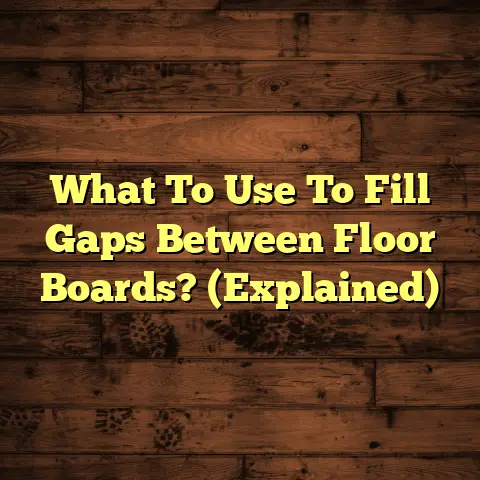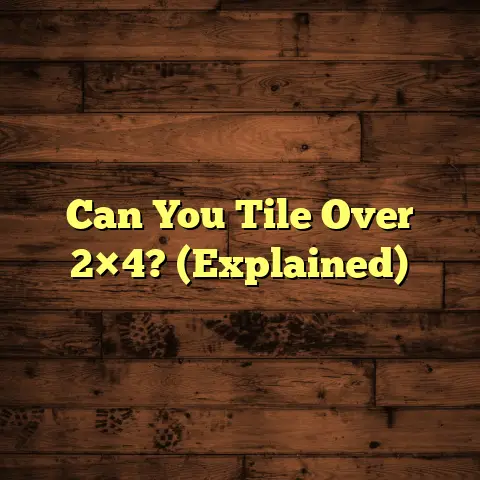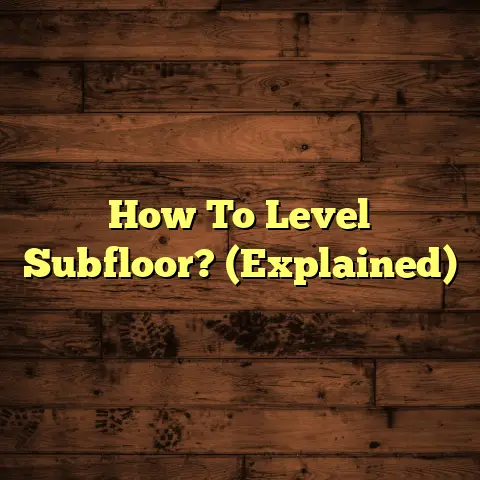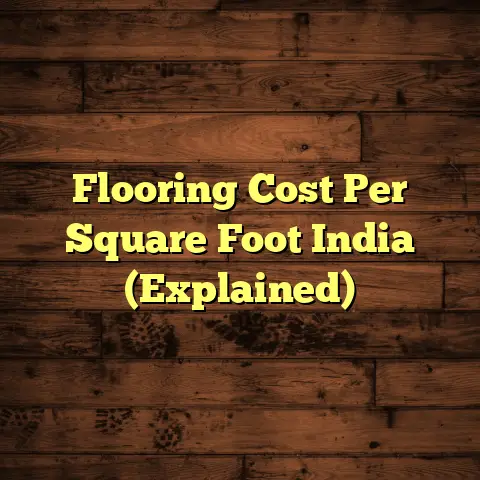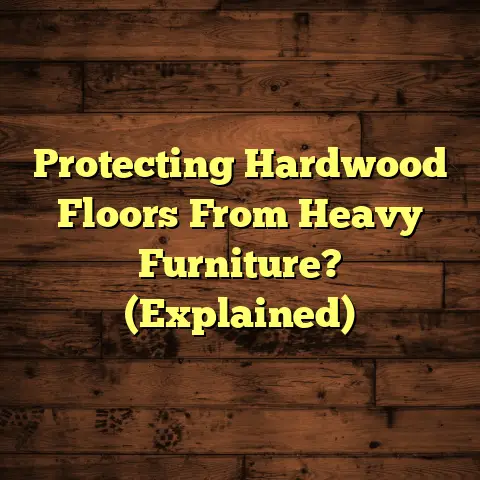Hardwood Flooring Cost Home Depot (Explained)
Hardwood Flooring Cost at Home Depot: A Comprehensive Guide
When it comes to flooring options, hardwood remains a popular choice for homeowners and builders alike. Its timeless appeal, durability, and the value it brings to properties make it an enduring favourite. However, the costs associated with hardwood flooring can vary widely based on several factors. This article will break down the costs of installing hardwood flooring, particularly through a retailer like Home Depot, while exploring various aspects from material selection to installation choices.
Major Cost Factors Impacting Hardwood Flooring Installation
Understanding the costs involved in hardwood flooring installation starts with recognizing the key factors that influence pricing:
1. Area Size
The size of the area you wish to cover is perhaps the most significant factor. The larger the space, the more materials and labour will be required. Costs are typically quoted per square foot, so knowing your measurements is crucial.
2. Hardwood Type
The type of hardwood chosen significantly affects the overall cost. Common hardwoods like oak and maple are often less expensive than exotic varieties such as teak or mahogany. Here’s a quick breakdown of popular wood types:
- Oak: Durable and relatively affordable.
- Maple: Harder and more resistant to scratches; slightly more expensive.
- Cherry: Rich colour but pricier.
- Walnut: Luxurious and expensive, known for its deep tones.
- Engineered Wood: Generally less costly and more stable than solid wood.
3. Material Grade
Hardwood comes in different grades, which can affect both appearance and price. Higher-grade woods are typically more visually appealing and have fewer knots and blemishes.
4. Installation Type
There are various installation methods – nail-down, glue-down, or floating floors – which can also influence costs. Professional installation tends to be more expensive than DIY approaches.
5. Additional Considerations
- Floor Removal: If existing flooring needs to be removed, this will incur additional costs.
- Subfloor Replacement: Damaged subfloors may need replacement before installing hardwood.
- Room Size/Layout: Complex layouts or irregular room shapes can increase installation complexity.
- Finishing Options: Staining and sealing can add to the cost, depending on the type of finish chosen (e.g., matte vs. glossy).
Cost Breakdown by Project Size and Hardwood Type
Here’s a detailed overview of estimated costs associated with different project sizes and hardwood types:
Small Project (100 sq. ft.)
- Material Costs: $300 – $800 (depending on wood type)
- Installation Costs: $200 – $400
- Total Estimated Cost: $500 – $1,200
Medium Project (500 sq. ft.)
- Material Costs: $1,500 – $4,000
- Installation Costs: $1,000 – $2,000
- Total Estimated Cost: $2,500 – $6,000
Large Project (1,000 sq. ft.)
- Material Costs: $3,000 – $8,000
- Installation Costs: $2,000 – $4,000
- Total Estimated Cost: $5,000 – $12,000
Hardwood Types Price Range
- Oak: $3 – $8 per sq. ft.
- Maple: $4 – $9 per sq. ft.
- Cherry: $5 – $10 per sq. ft.
- Walnut: $6 – $15 per sq. ft.
- Engineered Wood: $2 – $7 per sq. ft.
Comparing Hardwood with Alternative Flooring Options
While hardwood offers unique benefits, it’s important to consider alternative flooring options:
| Flooring Type | Cost per sq. ft. | Pros | Cons |
|---|---|---|---|
| Hardwood | $3 – $15 | Durable, aesthetically pleasing | Expensive, can scratch |
| Laminate | $1 – $5 | Affordable, easy to install | Less durable than wood |
| Vinyl | $2 – $7 | Water-resistant, versatile | May not add as much value |
| Carpet | $1 – $5 | Comfortable, warm | Can stain easily, requires more maintenance |
Signs Your Hardwood Floors Need Replacement
Identifying when to replace hardwood floors is crucial for maintaining your home’s appeal and safety:
- Severe Scratches and Gouges: When refinishing no longer improves appearance.
- Warping or Buckling: Often due to moisture issues; may not be fixable.
- Persistent Creaking or Noise: Indicates structural problems.
- Discolouration: Stains that cannot be removed through cleaning.
Refinishing vs. Replacement
If your hardwood floors show signs of wear but are structurally sound, refinishing can restore their beauty at a lower cost than replacement. However, if they exhibit significant damage or age-related issues, replacement may be the better option.
Pros and Cons of Hardwood Flooring
Pros:
- Aesthetics: Offers a timeless look that enhances home value.
- Durability: With proper care, hardwood floors can last decades.
- Versatile Styles: Available in various styles and finishes to suit any décor.
Cons:
- Cost: Generally more expensive than other flooring options.
- Maintenance: Requires regular upkeep to prevent scratches and damage.
- Sensitivity to Moisture: Not ideal for areas prone to high humidity.
Professional Installation vs. DIY
Choosing between professional installation and DIY can significantly impact your overall costs:
Professional Installation
- Cost: Typically ranges from $1 to $4 per sq. ft. depending on complexity.
- Skills Required: Requires knowledge of flooring installation techniques.
- Tools Needed: Professional tools can be costly if not already owned.
DIY Installation
- Cost Savings: Can save on labour costs but requires investment in tools.
- Skill Level: Must be comfortable with measuring and cutting materials.
- Time Commitment: DIY can take longer without experience.
Questions to Ask Hardwood Flooring Contractors
Before hiring a contractor for your hardwood flooring project, consider asking:
- What is your experience with hardwood flooring installation?
- Can you provide references from previous clients?
- What warranties do you offer on materials and installation?
- How do you handle unexpected issues during installation?
- What steps do you take to ensure proper acclimation of the wood?
Hardwood Floor Care and Maintenance Tips
To maximize the longevity of your hardwood floors:
- Regular Cleaning: Sweep or vacuum regularly to remove dirt and debris.
- Moisture Control: Use a damp mop; avoid excess water exposure.
- Refinishing Schedule: Plan to refinish every 5–10 years depending on wear.
- Protective Measures: Use area rugs and felt pads under furniture legs.
- Climate Control: Maintain stable indoor humidity levels to prevent warping.
Conclusion
Investing in hardwood flooring can significantly enhance the beauty and value of your home. By understanding the various cost factors — including materials, installation methods, and maintenance needs — you can make informed decisions that align with your budget and aesthetic preferences. Whether opting for professional installation or taking on a DIY project, thorough planning will ensure you enjoy the benefits of hardwood flooring for years to come.
